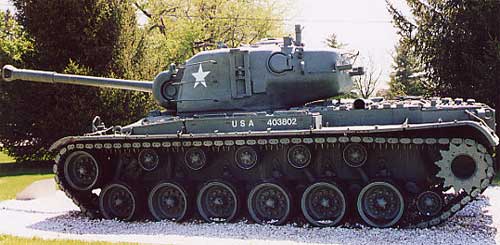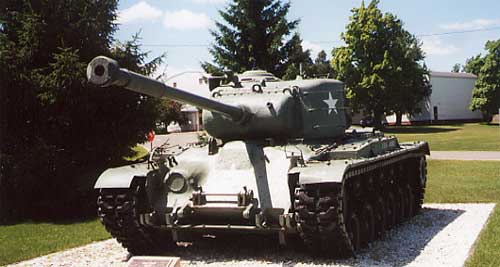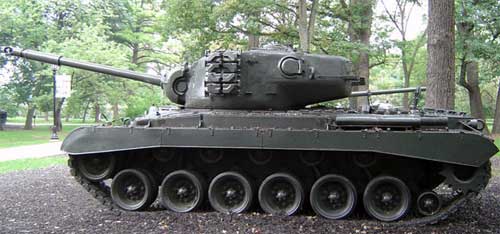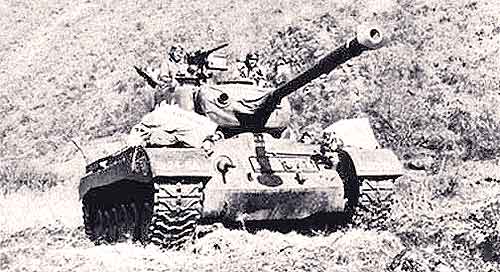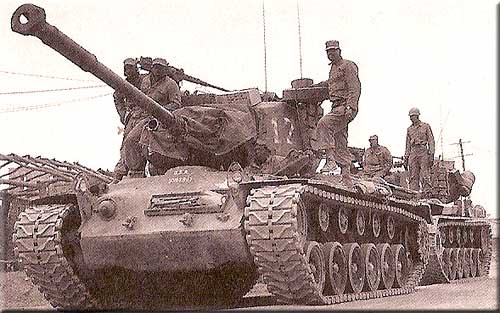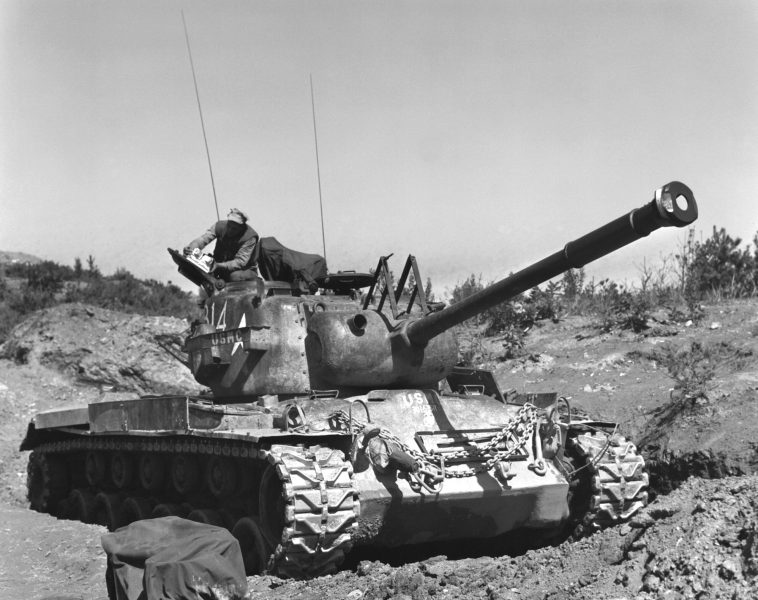
Medium tank M46 "Patton" or "General Patton"
Medium tank M46 "Patton" or "General Patton"General Patton - in honor of General George Smith Patton, usually shortened to "Patton".
The M46 Patton had a combat weight of 44 tons and was armed with a 90-mm MZA1 semi-automatic cannon, which, together with a mask bolted to the cannon cradle, was inserted into the turret embrasure and mounted on special trunnions. An ejection device was mounted on the muzzle of the gun barrel to clean the bore and cartridge case from powder gases after firing. The main armament was supplemented by two 7,62-mm machine guns, one of which was paired with a cannon, and the second was installed in the frontal armor plate. A 12,7 mm anti-aircraft machine gun was located on the roof of the tower. The gun ammunition consisted of unitary shots, most of which were placed on the bottom of the tank hull under the fighting compartment, and the rest were taken out of the lower ammunition rack and placed on the left side of the turret and on the sides of the fighting compartment.
The M46 Patton had a classic layout: the engine and transmission were located in the rear of the vehicle, the fighting compartment was in the middle, and the control compartment was located in front, where the driver and his assistant (he was also a machine gun shooter) were located. In the control compartment, the units were located quite freely, which cannot be said about the power compartment, which was arranged so tightly that in order to flush the fuel filters, adjust the ignition system, service generators, change gasoline pumps and other components and assemblies, it was necessary to remove the entire block of the power plant and transmission .
This arrangement was caused by the need to place in the power compartment two large-capacity fuel tanks and a significant 12-cylinder Continental air-cooled gasoline engine with a V-shaped arrangement of cylinders, which developed a power of 810 hp. With. and provided traffic on the highway with a maximum speed of 48 km / h. The transmission of the “Cross-Drive” type of the Allison company had hydraulic control drives and was a single unit, which consisted of a primary gearbox, an integrated torque converter, a gearbox and a rotation mechanism. The gearbox had two speeds when moving forward (slow and accelerated) and one when moving backward.
The gearbox and the turning mechanism were controlled by one lever, which served both for shifting gears and for turning the tank. The undercarriage of the M46 tank differed from the undercarriage of its predecessor M26 in that on the M46, one additional small-diameter roller was installed between the drive wheels and the rear road wheels to ensure constant track tension and prevent them from dropping. In addition, second shock absorbers were installed on the front suspension units. The rest of the chassis of the "Patton" was similar to the chassis of the M26. The M46 tank was adapted to operate in low temperature conditions and had special equipment to overcome water obstacles.
The performance characteristics of the medium tank M46 "Patton":
Sources:
| ||||||||||||||||||||||||||||||||||||||

 In 1946, the M26 Pershing tank, which proved itself well in the battles of World War II, was modernized, which consisted in installing a new, more powerful engine, using a large hydromechanical power transmission, installing a gun of the same caliber, but with somewhat improved ballistic data, a new control system and new fire control drives. The design of the undercarriage was also changed. As a result, the tank became heavier, but its speed remained the same. In 1948, the modernized vehicle was put into service under the designation M46 "Patton" and until 1952 was considered the main tank of the US Army.
In 1946, the M26 Pershing tank, which proved itself well in the battles of World War II, was modernized, which consisted in installing a new, more powerful engine, using a large hydromechanical power transmission, installing a gun of the same caliber, but with somewhat improved ballistic data, a new control system and new fire control drives. The design of the undercarriage was also changed. As a result, the tank became heavier, but its speed remained the same. In 1948, the modernized vehicle was put into service under the designation M46 "Patton" and until 1952 was considered the main tank of the US Army.